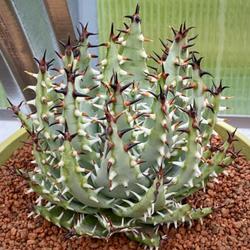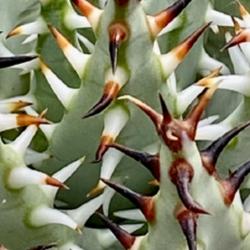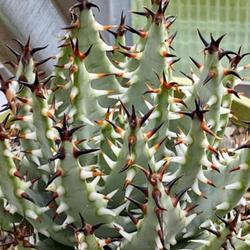General Plant Information (Edit)
| Plant Habit: |
Cactus/Succulent
|
| Life cycle: |
Perennial
|
| Minimum cold hardiness: |
Zone 8b -9.4 °C (15 °F) to -6.7 °C (20 °F)
|
| Plant Spread: |
6-15 inches |
| Leaves: |
Evergreen
|
| Fruit: |
Dehiscent
|
| Flowers: |
Showy
|
| Flower Color: |
Bi-Color: Red opening to yellow
|
| Flower Time: |
Winter
|
| Suitable Locations: |
Xeriscapic
|
| Uses: |
Provides winter interest
Will Naturalize
|
| Wildlife Attractant: |
Hummingbirds
|
| Resistances: |
Drought tolerant
|
| Propagation: Seeds: |
Can handle transplanting
Other info: Sow seeds in sandy soil. Seeds germinate in a few weeks at temperatures between 68 and 75 degrees F. Seedlings need moist but well-drained soil.
|
| Propagation: Other methods: |
Cuttings: Stem
Offsets
Other: Stems cut below a node root easily. Cut a stem that has gotten leggy, let it dry out for at least a few hours to form a seal on the cut surface. Place the cutting in rooting medium kept moist, but not wet, until roots form.
|
| Pollinators: |
Birds
|
| Containers: |
Suitable in 1 gallon
Needs excellent drainage in pots
|
| Miscellaneous: |
Tolerates poor soil
With thorns/spines/prickles/teeth
|
| Awards and Recognitions: |
RHS AGM
|
| Conservation status: |
Endangered (EN)
|
- Krimpvarkie
- Aloe
- Igel
- Goree
- Accepted: Aloe erinacea
- Synonym: Aloe melanacantha var. erinacea
Posted by
Baja_Costero (Baja California - Zone 11b) on Jan 26, 2018 10:46 PM concerning plant:
Extra spiny aloe (like a hedgehog) with gray/blue-green leaves that may grow as a solitary rosette to about 8-9 inches wide or in a tight clump. Very distinctive appearance. Slow growing. From subtropical Namibia, a bit north of the Orange River, an area with very low rainfall, mostly in winter. Old plants may grow a relatively long stem for the size of the rosette, and they may branch to form clumps in nature.
Excellent plant for extreme exposure situations. Well suited to dry Mediterranean (winter rainfall) climates. Drought tolerant (requires no supplemental water in our mild, 10"/yr. winter rainfall climate). Provide excellent drainage. Do not overwater during extreme summer heat. May be somewhat self-compatible.
Related to the similar looking A. melanacantha, from south of the Orange River in the winter rainfall part of South Africa. Aloe erinacea is a smaller plant, with paler, grayer leaves. The surface texture of its leaves is less rough, and the leaf sap is a brighter lemon yellow. The flowers are smaller. Both plants make bicolored flowers (red opening to yellow or pink/orange) with exserted stamens/style in winter. A. melanacantha flowers earlier than A. erinacea here.
The rumors that Aloe erinacea does not flower in cultivation are false. In our mild climate the plant flowers at about 8-10 years of age.
| Thread Title |
Last Reply |
Replies |
| aloe vera by zalmy1 |
Nov 23, 2020 10:09 PM |
1 |
« Add a new plant to the database
» Search the Aloes Database: by characteristics or by cultivar name
« See the general plant entry for Aloes (Aloe)
« The Aloes Database Front Page
« The Plants Database Front Page













